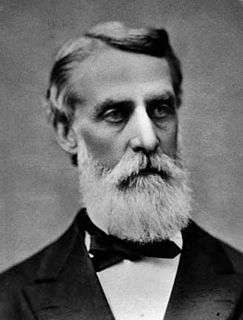
Charles Reed Bishop was an American businessman, politician, and philanthropist in Hawaii. Born in Glens Falls, New York, he sailed to Hawaii in 1846 at the age of 24, and made his home there, marrying into the royal family of the kingdom. He served several monarchs in appointed positions in the kingdom, before its overthrow in 1893 by Americans from the United States and organization as the Territory of Hawaii.

Washington Place is a Greek Revival palace in the Hawaii Capital Historic District in Honolulu, Hawaiʻi. It was where Queen Liliʻuokalani was arrested during the overthrow of the Hawaiian Kingdom. Later it became the official residence of the governor of Hawaiʻi. In 2007, it was designated as a National Historic Landmark. The current governor's residence was built in 2008 behind the historic residence, and is located on the same grounds as Washington Place.
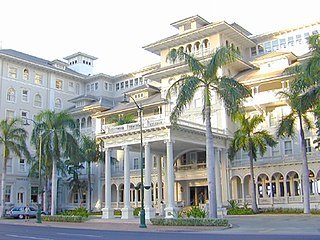
The Moana Hotel is a historic hotel building in Honolulu, Hawaii, located at 2365 Kalākaua Avenue in the Waikiki neighborhood. Built in the late 19th century as the first hotel in Waikiki, the Moana opened in 1901. It is listed on the National Register of Historic Places. The building is currently part of the resort complex known as Moana Surfrider, A Westin Resort & Spa and is managed by Westin Hotels & Resorts.

Sonnenberg Gardens and Mansion State Historic Park is a 50-acre (20 ha) state park located at 151 Charlotte Street in Canandaigua, New York, at the north end of Canandaigua Lake, in the Finger Lakes region of Upstate New York. The house and gardens are open to the public every day, May through October.

The Palace Hotel is a landmark historic hotel in San Francisco, California, located at the southwest corner of Market and New Montgomery streets. The hotel is also referred to as the "new" Palace Hotel to distinguish it from the original 1875 Palace Hotel, which had been demolished after being gutted by the fire caused by the 1906 San Francisco earthquake.

The H. Alexander Walker Residence or Walker Estate is a historic home located in the upper Nuʻuanu Valley of Honolulu, Hawaii.

The Hinds House is a historic building in Santa Cruz, California. It was built in 1888 and 1889 by Alfred J. Hinds and his wife Sarah. Its Victorian style has been preserved and it is the largest surviving Stick-Eastlake house in Santa Cruz County. Today the Hinds House is a historical inn with rooms rented out to guests visiting or relocating to Santa Cruz.

Boettcher Estate, also known as Kalama Beach Park, is a former beachfront estate in Kailua, Honolulu County, Hawaii, with a house designed by Vladimir Ossipoff and landscape designed by Richard Tongg. It became a municipal park in 1978 and was listed on the National Register of Historic Places in 2002.
Charles William “C.W.” Dickey was an American architect famous for developing a distinctive style of Hawaiian architecture. He was known not only for designing some of the most famous buildings in Hawaiʻi—such as the Alexander & Baldwin Building, Halekulani Hotel, Kamehameha Schools campus buildings—but also for influencing a cadre of notable successors, including Hart Wood, Cyril Lemmon, Douglas Freeth, Roy Kelley, and Vladimir Ossipoff.
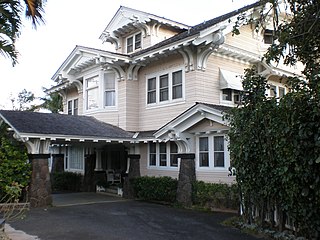
The John Guild House, now known as Manoa Valley Inn, at 2001 Vancouver Drive in Honolulu, Hawaii, was purchased in 1919 by John Guild, a Honolulu businessman. It had been built four years earlier by Iowa lumber dealer Milton Moore and has been refurbished and restored several times over its lifespan. It was listed on the National Register of Historic Places in 2002.

The Merchant Street Historic District in Honolulu, Hawaii, was the city's earliest commercial center.

Volcano House is the name of a series of historic hotels built at the edge of Kīlauea, within the grounds of Hawai'i Volcanoes National Park on the Island of Hawai'i. The original 1877 building is listed on the National Register of Historic Places and now houses the Volcano Art Center. The hotel in use today was built in 1941 and expanded in 1961.

The Liljestrand House at 3300 Tantalus Drive in Honolulu, Hawaii, was designed by Vladimir Ossipoff for Betty and Howard Liljestrand, a doctor and nurse who had bought the hillside site overlooking downtown Oahu in 1948. Completed in 1952, the house "was perhaps Ossipoff's most intricate as well as his most widely publicized domestic commission." After it was featured in House Beautiful magazine as a Pace Setter House in 1958, it attracted hundreds of visitors in organized weekly tours. It was listed on the National Register of Historic Places in 2008.

The Bond District is a collection of historic buildings located in the district of North Kohala on the island of Hawaii. The district has three sections: the homestead of missionaries Ellen and Reverend Elias Bond (1813–1896), Kalahikiola Church, and the Kohala Seminary.

The R. N. Linn House, also known as the Robert A. and Eleanor C. Nordyke Residence, at 2013 Kakela Drive in Honolulu, Hawaiʻi, was built in 1928 in the style of architecture then emerging in Hawaiʻi during the 1920s. Although it is relatively modest cottage, it exhibits such typical elements of that style as a double-pitched hip roof, exposed rafters, casement windows, an open floor plan, Chinese interior motifs, and a panoramic view. Its architect was J. Alvin Shadinger, who was noted especially for his interior designs. The house was listed in the National Register of Historic Places in 1986.

The Chinatown Historic District is a neighborhood of Honolulu, Hawaii, known for its Chinese American community. It is one of the oldest Chinatowns in the United States.

The Georges de S. Canavarro House, also known as the Canavarro Castle, at 2756 Rooke Ave., Honolulu, Hawaiʻi, was built in 1924–1927 for Georges de Souza Canavarro, son of the longtime Consul-General of Portugal in Hawaiʻi, Antonio de Souza Canavarro. It was designed by Hart Wood, the leader of a group of architects aiming to develop a style suitable for the climate and lifestyle of the islands. It was listed on the National Register of Historic Places in 1980 as a fine example of the Mediterranean Revival style employed for several large estates of that era, most notably Walter F. Dillingham's La Pietra. The design in this case was inspired by Sicilian villas.
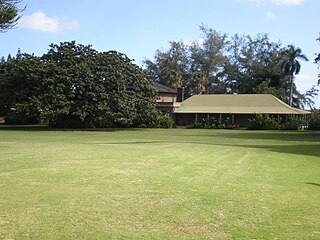
Grove Farm is a historic agricultural site on Kauai in the Hawaiian Islands.
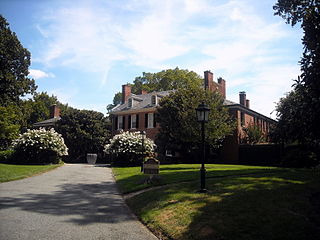
Evermay is a historic Federal architecture-style house at 1623 28th Street, Northwest, Washington, D.C., in the Georgetown neighborhood. The property originally extended south to Q Street, but the other houses were divided from the property.
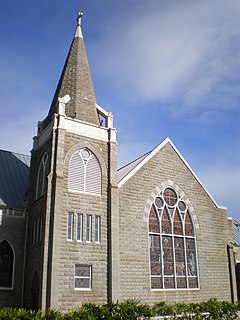
Edgar Allen Poe Newcomb was an architect, also known as E. A. P. Newcomb and Edgar A. P. Newcomb. The majority of his accomplishments were in Boston and Honolulu. Newcomb was also a bass vocalist who composed dozens of songs and at least one opera.




















